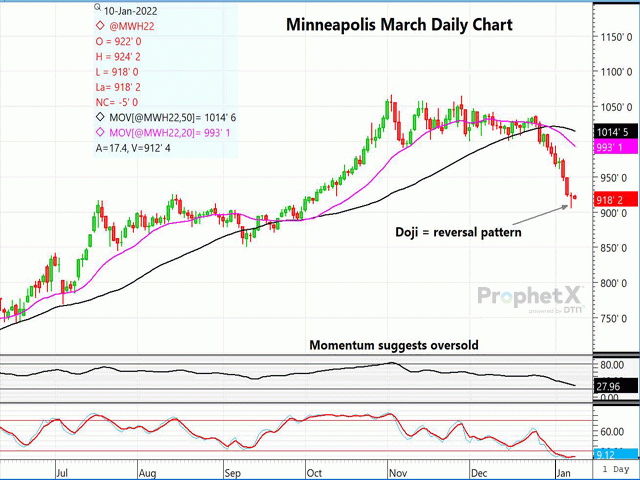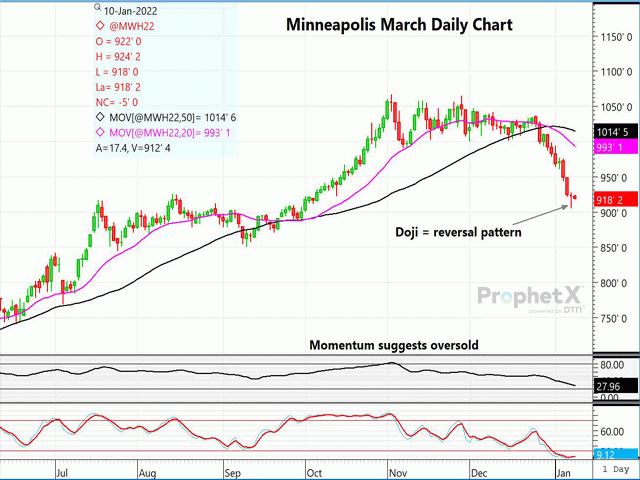Technically Speaking
Wheat Markets Oversold; Soybeans, Meal Overbought
Minneapolis wheat futures have plunged $1.60 per bushel just since the end of November. There really were not any great changes in the fundamental supply and demand outlook to drive the weakness. U.S. and world balance sheets remained very tight, with the lowest U.S. all-wheat ending stocks in eight years.
The way Friday's trade opened and closed at virtually the same level is referred to as a "doji" in Japanese candlestick terminology. That is typically a sign of indecision and usually results in a trend change. However, it would be much more convincing with a higher close on Monday, which is still in jeopardy early Monday.
Despite new record large wheat crops likely in both Argentina and Australia pressuring the wheat markets, that alone is hardly worth a fall of $1.60 per bushel. Minneapolis wheat is now very oversold and appears due for a bounce. A few bullish developments to keep an eye on are the dryness plaguing the hard red winter wheat areas and the prospect for South American dryness to lead corn and soybeans higher. Major support for Minneapolis March wheat is in the $8.90 to $9.05 range on a further fall.
MARCH SOYBEAN MEAL FUTURES:Just since the end of November, March soy meal futures have risen $94 per ton. While it is true t U.S. soy meal exports could be a beneficiary of sliding soybean production in both Brazil and Argentina, it seems the meal market has risen too far, too fast.
P[L1] D[0x0] M[300x250] OOP[F] ADUNIT[] T[]
A new contract high in March meal was scored Friday with meal rising nearly $22 per ton last week. However, the jury is still out on crops. Brazil's economic agricultural firm CONAB releases new South American crop estimates Tuesday, Jan. 11, and USDA releases its estimates Wednesday, Jan. 12.
The meal market is very overbought based on momentum indicators and the indicators are showing bearish divergence from price -- typically a sign that a correction could be imminent.
MARCH SOYBEAN FUTURES:As in soybean meal futures, spot soybean futures soared last week, rising an impressive 72 cents per bushel, to the highest level since June. While it is true U.S. soybean exporters could certainly benefit from the expected decline in South American soy production, the jury is still out.
As in meal, soybeans, on the rally, may have become overextended. Momentum indicators are showing bearish divergence and are in the overbought range. Although the overall trend in soybeans and the soy complex remains higher, we could see a setback ahead of the USDA crop reports this week. However, on a resumption of the rally, the next level of resistance looks to be about 30 cents higher at $14.45.
Comments above are for educational purposes and are not meant to be specific trade recommendations. The buying and selling of grain and soybean futures involve substantial risk and are not suitable for everyone.
Dana Mantini can be reached at Dana.Mantini@DTN.com
Follow him on Twitter @mantini_r
(c) Copyright 2022 DTN, LLC. All rights reserved.






Comments
To comment, please Log In or Join our Community .